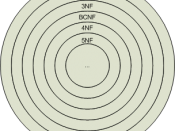Database Normalization
By: K. Turner
Normalization in its most literal sense means: To make (a text or language) regular and consistent, especially with respect to spelling or style. 1 Normalization with regard to database technology takes on a slightly different meaning, but the concepts of consistency and organization remain the same.
As a database grows, it grows not only in size, but also complexity. This inevitability provides a need to maintain order and organization. The best way to keep things streamlined is to reduce complexity and minimize errors and redundancy associated with the increasing size of the database. To reduce the amount of redundant data, tables are created, on an individual basis, to store and maintain information and their associative attributes. This process, referred to as normalization, in database parlance. This not only reduces database complexity, but can also be a great tool for reducing errors such as typographical and misspelled words, as data is stored only once, instead of repeated multiple times.
The process of normalization strives to eliminate errors which can be inherent to the database milieu. These errors include; update, deletion, and insertion errors.
To summarize normalization it could be said that; Normalization is part of any successful database design process; without normalization, database systems can be inaccurate, slow, and inefficient, and they might not produce the data you expect. Maintaining organization on the ground floor will help to obviate some of the aforementioned problems as the database grows and evolves.
The Process
*When you normalize a database, you keep four goals in mind:
*Arranging data into logical groups. These groups can then be associated via relationships.
*Minimizing the amount of duplicate data stored in a database, this helps to keep the database streamlined and helps reduce redundancy.
*Organizing the data such that, when you modify it,


